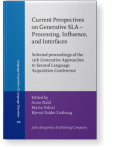Chapter 12
There isn’t a problem with indefinites in existential constructions in L2-English
This is an exploratory study of how both native English speakers and L1-Mandarin L2-English learners judge different types of indefinites in both existential there-constructions and copular constructions with an indefinite subject. Unlike English, Mandarin lacks an a/one distinction, has two different types of existential constructions, and lacks numeral partitives. It is argued that target differentiation among indefinite types and syntactic constructions presents a Poverty of the Stimulus problem. Learners are found to overcome this problem: while there is limited evidence of L1-transfer from Mandarin to English, the learners largely exhibit the same patterns as native speakers in an acceptability judgment task. It is argued that a universal Gricean principle helps learners acquire the a/one distinction.
Article outline
- 1.Introduction
- 2.Background: Existential constructions and indefinite types
- 2.1Existential constructions and types of indefinites in English
- 2.2Existential constructions and types of indefinites in Mandarin
- 2.3Study motivation and research questions
- 3.Methodology
- 3.1Participants
- 3.2AJT format
- 3.3Predictions
- 4.Results
- 4.1NS-L2 analyses
- 4.2Proficiency effects
- 5.Discussion
- 6.Conclusion
-
Notes
-
References
This content is being prepared for publication; it may be subject to changes.
